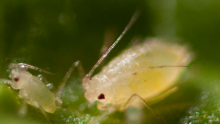
Innovation in agriculture refers to the development and implementation of new ideas, technologies, and practices in the agricultural sector.

5
Opportunities are increasing for farmers and land managers to earn revenues from storing carbon in soils or vegetation, or by reducing baseline GHG emissions from crop and livestock production.

2
The Peach-Potato Aphid (PPA) known as Mysus persicae is known to feed on a wide range of plants including several grown as crops.
They are known to transmit viruses to crop plants including Turnips…
1
The importance of good mental health is increasingly being recognised across agriculture. Use this page to connect to useful initiatives and resources.

Crop physiology is the study of how plants function and respond to their environment. It involves understanding the factors that affect crop growth and development, such as light, temperature, water…

Diffuse pollution in agriculture refers to the contamination of water, soil, and air by chemicals, nutrients, and other substances that are used or produced in agricultural activities.

1
Integrated farming is a type of farming that aims to maximize the efficiency and productivity of the farm by integrating different types of crops and animals into a single system.

Land use refers to the way that land is used and managed for various purposes, such as agriculture, housing, industry, and recreation.










